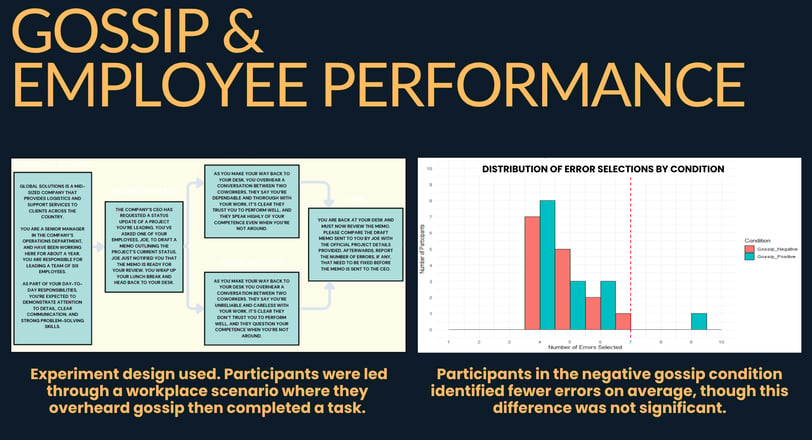

Insights
Participants who overheard negative gossip identified fewer errors and reported lower confidence, but the differences were not statistically significant.
Exposure to negative gossip influenced how participants felt during the task (e.g., more distracted, more judged), but the results were not statistically significant.
While no significance was found, results may still suggest that indirect feedback, like overheard gossip, tends to create a negative employee experience.
Methods + Approach
Using a between-subjects experimental design (N=30), participants were randomly assigned to overhear either positive or negative workplace gossip about their ability to perform a task. After reading the scenario, they completed a memo task requiring error detection, followed by a short survey assessing confidence, distraction, and perceived judgment.
Primary Skills Applied: Hypothesis Testing | Survey Design | Statistics | Data Cleaning | Literature Review
Problem
Gossip can sometimes be dismissed as harmless, but it may have powerful psychological consequences for employees. While research has explored the spread of gossip, less is known about its effects, especially when employees become the target. Drawing on literature from social psychology, this project investigated whether negative gossip about an employee's competence can impair performance and influence self-perceptions, even in the absence of direct confrontation.
Potential Applications
Although results did not show statistical significance, psychological safety remains important in organizations. Organizations should:
Train managers on indirect feedback cues and their effects
Design environments where trust and psychological safety reduce second-guessing
Discuss how reputation, bias, and feedback shape team effectiveness
Limitations
Sample Size: With N=30, the study was underpowered to detect small effects.
Contextual Validity: The memo task simulated work, but findings may differ in high-stakes environments.
Generalizability: Participants were not drawn from a working population, limiting workplace relevance.
Tools Used: R | Qualtrics
